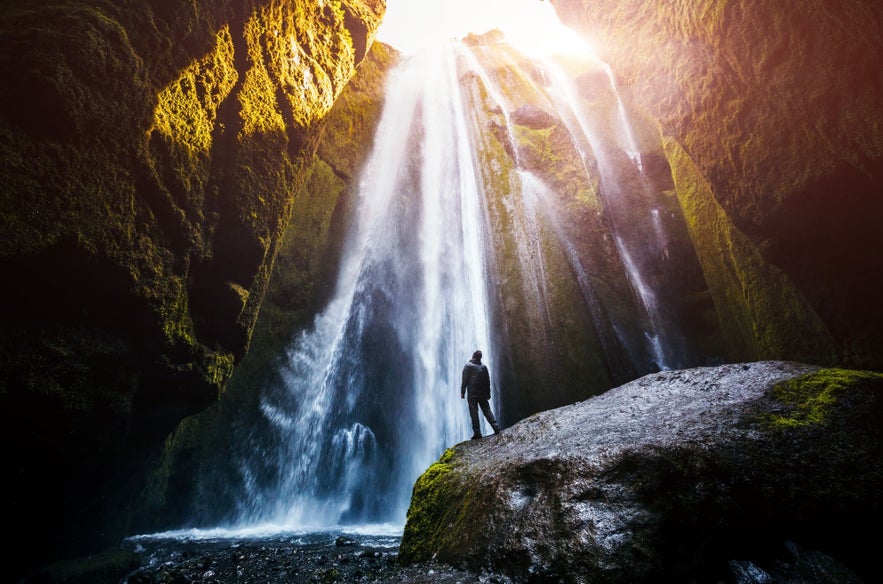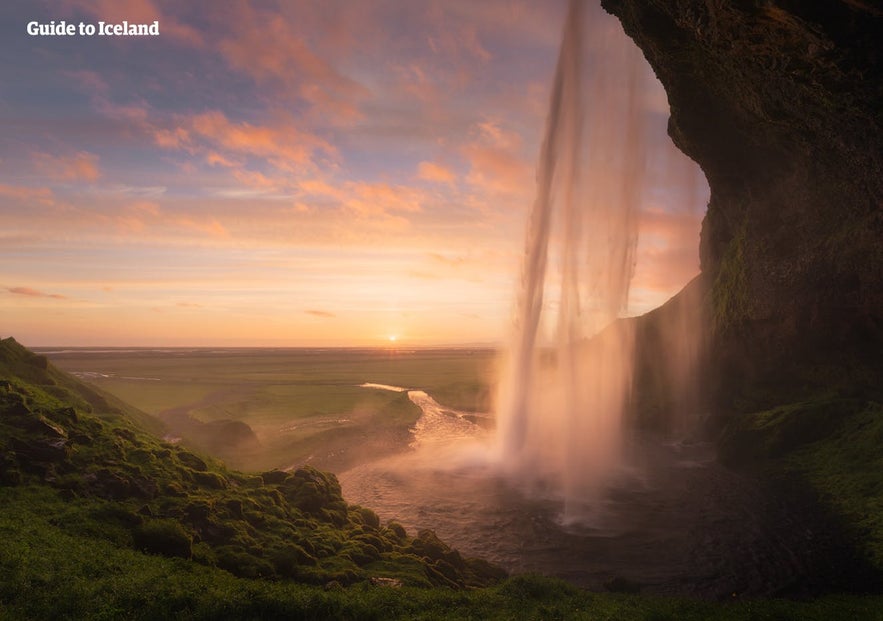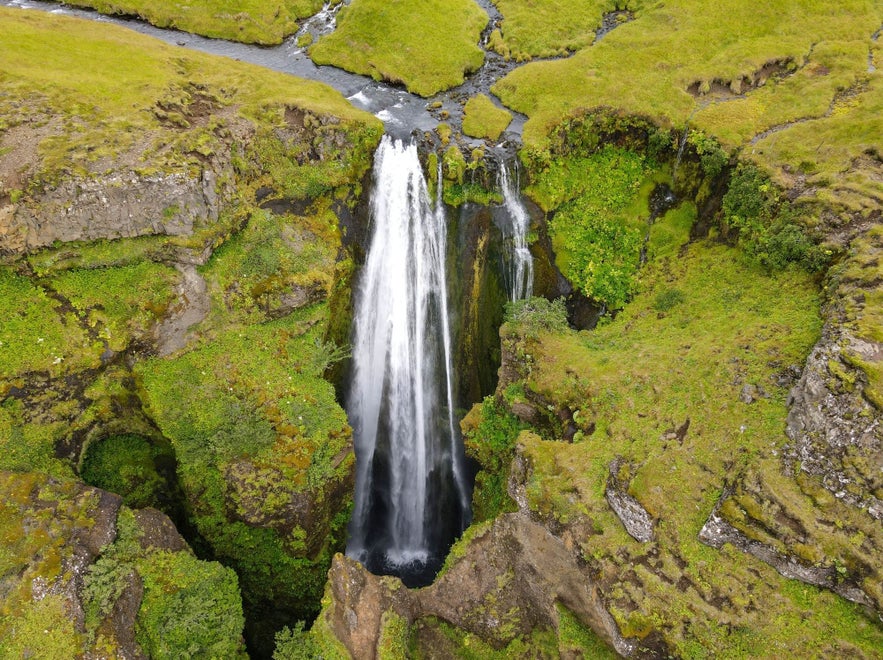
Hidden in a narrow gorge along Iceland’s southern coastline, Gljufrabui Waterfall is one of the country’s most secluded natural sights. Enclosed by moss-covered cliffs, it offers a peaceful atmosphere and a dramatic reveal for those who venture inside its rocky passage.
The hidden Gljufrabui Waterfall is just a short walk from Seljalandsfoss, one of Iceland’s most visited waterfalls and a staple on South Coast tours.
Why You Can Trust Our Content
Guide to Iceland is the most trusted travel platform in Iceland, helping millions of visitors each year. All our content is written and reviewed by local experts who are deeply familiar with Iceland. You can count on us for accurate, up-to-date, and trustworthy travel advice.
While Seljalandsfoss is known for its walk-behind cascade, Gljufrabui offers a quieter, more tucked-away experience. Seeing both gives travelers a unique contrast in setting and atmosphere, all within the same stop.
Thanks to its location near major landmarks, Gljufrabui is often included in day trips from Reykjavik that explore the southern region. Some itineraries, such as a South Coast tour with glacier hiking, pair the waterfall with beaches, glaciers, and other natural sights for a well-rounded day.
Gljufrabui is also featured in specialized waterfall tours that highlight both well-known sights and lesser-visited locations. It fits easily into most itineraries in the southern region and rewards those who take a moment to step off the main path.
Key Takeaways
-
A Hidden Gem Near Seljalandsfoss — Gljufrabui Waterfall is a less crowded but equally breathtaking stop than Seljalandsfoss.
-
Geological and Natural Beauty — The waterfall cascades 131 feet (40 meters) into a moss-covered canyon formed by volcanic and glacial activity.
-
Nearby Activities — Visitors can explore other iconic South Coast landmarks in a region known for hiking, glacier tours, and puffin-watching.
-
Different Sights for Different Seasons — Summer offers better accessibility, while winter provides a frozen wonderland.
The Geography of Gljufrabui Waterfall
Gljufrabui means “canyon dweller” in Icelandic. The name refers to the waterfall being partially hidden from view within a canyon. Visitors must follow a small trail to access the narrow canyon where water falls 131 feet (40 meters) from a cliff into the majestic pool.
The waterfall is part of the Seljalandsa River, which starts as snow on the Eyjafjallajokull Glacier Volcano.
The canyon walls consist of black basalt rock that formed as a result of thousands of years of volcanic activity. You can climb specific sections of the canyon to get a better perspective of the waterfall and take photos.
It is recommended for visitors to wear sturdy, waterproof shoes since the trail entrance requires wading through the rocky stream. While the wade isn’t difficult, it’s made much easier with appropriate footwear.
Attractions Around Gljufrabui Waterfall
 Gljufrabui Waterfall is very easy to reach from the Ring Road. Easy accessibility and a wide range of natural landmarks make the region one of the most traveled on the South Coast.
Gljufrabui Waterfall is very easy to reach from the Ring Road. Easy accessibility and a wide range of natural landmarks make the region one of the most traveled on the South Coast.
Seljalandsfoss Waterfall is just a short walk from Gljufrabui Falls. Both are fed by the Eyjafjallajokull Glacier Volcano. Seljalandsfoss Falls is 197 feet (60 meters) tall, and water plummets from a concave cliff, which allows visitors to fully encircle the cascade. It’s one of Iceland’s most photographed waterfalls.
Skogafoss Waterfall is another popular attraction in the area. It’s about 16 miles (26 kilometers) from Gljufrabui Falls. Surrounded by vibrant mossy-green rock, Skogafoss Waterfall is considered one of the most beautiful in Iceland.
If you crave a hiking adventure, Solheimajokull Glacier is about 23 miles (37 kilometers) from Gljufrabui Waterfall. It’s one of Iceland’s most popular destinations for glacier hiking tours.
Finally, consider exploring the cliffs of the Dyrholaey Peninsula if you plan on traveling further along the South Coast. Visitors will enjoy the peninsula’s famous Reynisfjara Black Sand Beach and may even catch a glimpse of puffins while exploring.
Plan Your Visit to Gljufrabui Waterfall

Add Gljufrabui Falls to your trip itinerary and enjoy a day (or two) of incredible natural sites and activities.
Here are a few tips to ensure you have a great visit:
-
The rocks can be slippery, so use caution when wading into the gorge.
-
A narrow trail and wooden staircase allow you to climb partway up the cliff.
-
Parking is available for a small fee in the main lot of Seljalandsfoss Waterfall.
-
There’s a nearby camping area called Hamragardar with facilities if you want to stay overnight.
Top Tours to Gljufrabui Waterfall
Book a tour of the South Coast and enjoy everything this famous region has to offer.
-
The South Coast Tour From Reykjavik — See Seljalandsfoss, Skogafoss, Reynisfjara Black Sand Beach, and glacier viewpoints.
-
3-Day South Coast & Golden Circle Ice Cave Tour — Combine glacier hikes, ice caves, and Iceland’s iconic attractions on this winter adventure.
-
Best Day Tour to Jokulsarlon Glacier Lagoon From Reykjavik — This day tour takes visitors all the way to the Jokulsarlon Glacier Lagoon.
If you’d rather go at your own pace, consider booking a self-drive tour package and plan the perfect Icelandic adventure.
-
South & West Iceland Self-Drive — Discover the best of Iceland’s South Coast and magical West on this slow-paced yet scenic one-week itinerary.
-
10-Day Self-Drive Tour of Ring Road & Snaefellsnes Peninsula — Make the most of your time and see the natural beauty and wonders that Iceland has to offer.
-
7-Day Northern Lights Self-Drive Tour — Spend a week chasing the northern lights while taking in all of Iceland’s South Coast's natural sights.
-
Incredible 1-Week Summer Self-Drive Tour of the Ring Road & Golden Circle — Explore all of Iceland’s hidden gems at your own pace.
FAQs About Gljufrabui Waterfall
Below are some frequently asked questions about visiting Gljufrabui Waterfall. The answers to these questions can help you plan your trip and ensure a safe and enjoyable experience.
Is there an entrance fee to Gljufrabui Waterfall?
No, Gljufrabui Waterfall is free to visit.
What’s the best time to visit Gljufrabui Waterfall?
Summer offers easier access to Gljufrabui Waterfall with lush greenery and long daylight hours. Winter offers a magical frozen scene but icy conditions.
Is swimming allowed at Gljufrabui Waterfall?
No, swimming is not recommended at Gljufrabui Waterfall as the water is cold and shallow, and the canyon is narrow.
Is Gljufrabui Waterfall suitable for children and older visitors?
Yes, Gljufrabui Waterfall is suitable for children, as long as they are accompanied by adults who exercise caution. The walk to the canyon is easy, but entering it requires stepping through a shallow stream and navigating slippery rocks.
Is Gljufrabui Waterfall usually crowded?
Gljufrabui Waterfall is less crowded than the nearby Seljalandsfoss Waterfall, but still popular.
Can I fly a drone at Gljufrabui Waterfall?
Drone usage is allowed at Gljufrabui Waterfall, but with restrictions due to visitor safety. Check local drone regulations before flying.
Can I visit Gljufrabui Waterfall at night?
Yes. In summer, the midnight sun allows for late-night visits to Gljufrabui Waterfall.
Are there any legends or folklore about Gljufrabui Waterfall?
According to Icelandic folklore, trolls and hidden people (elves) live near Gljufrabui Waterfall and cliffs.
Can I drink the water from Gljufrabui Waterfall?
Yes. Iceland’s glacial and spring water is among the cleanest in the world, but it’s best to drink from flowing streams around Gljufrabui Waterfall rather than still water.
Is Gljufrabui Waterfall wheelchair accessible?
No. The path to Gljufrabui Waterfall involves walking over uneven terrain, stepping through water, and entering a narrow gorge.
Plan Your Icelandic Adventure
 Gljufrabui Waterfall is just one of Iceland's many hidden gems. If you've enjoyed learning about this unique location, there's much more to discover about Iceland's stunning landscapes and natural wonders.
Gljufrabui Waterfall is just one of Iceland's many hidden gems. If you've enjoyed learning about this unique location, there's much more to discover about Iceland's stunning landscapes and natural wonders.
Explore our other guides to uncover more breathtaking waterfalls, majestic glaciers, and the rich folklore that makes Iceland such a fascinating place to visit.









